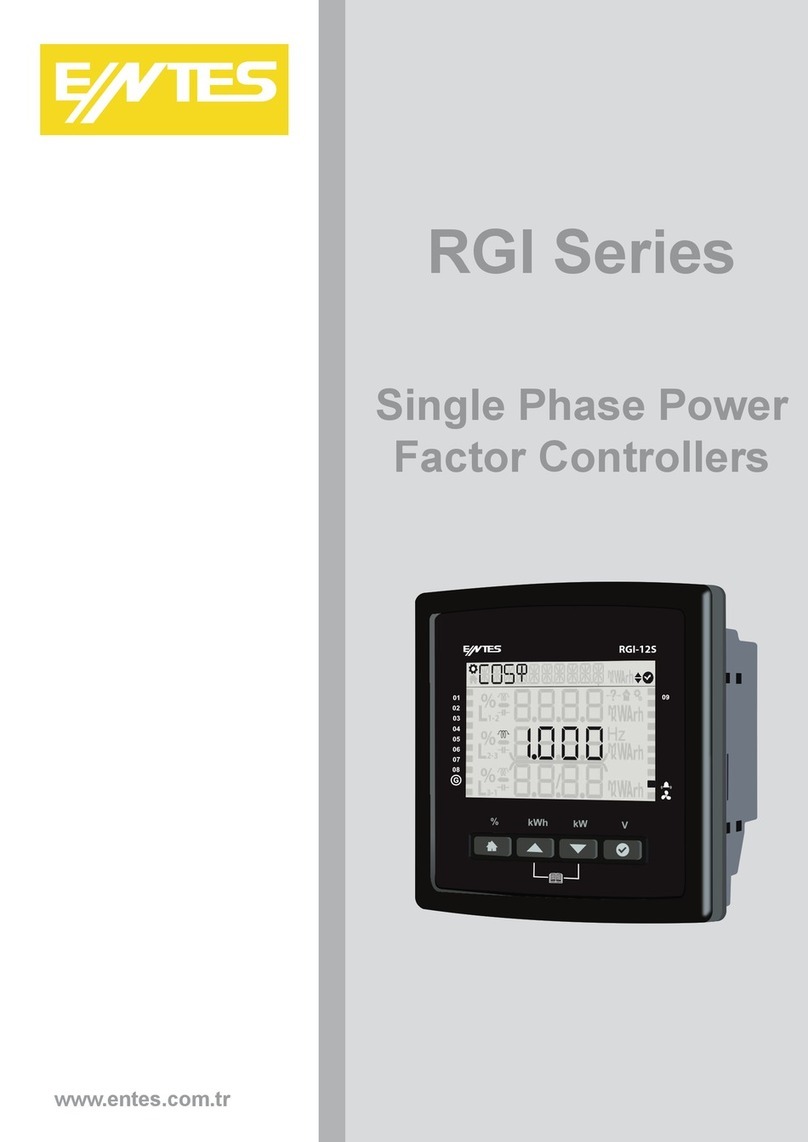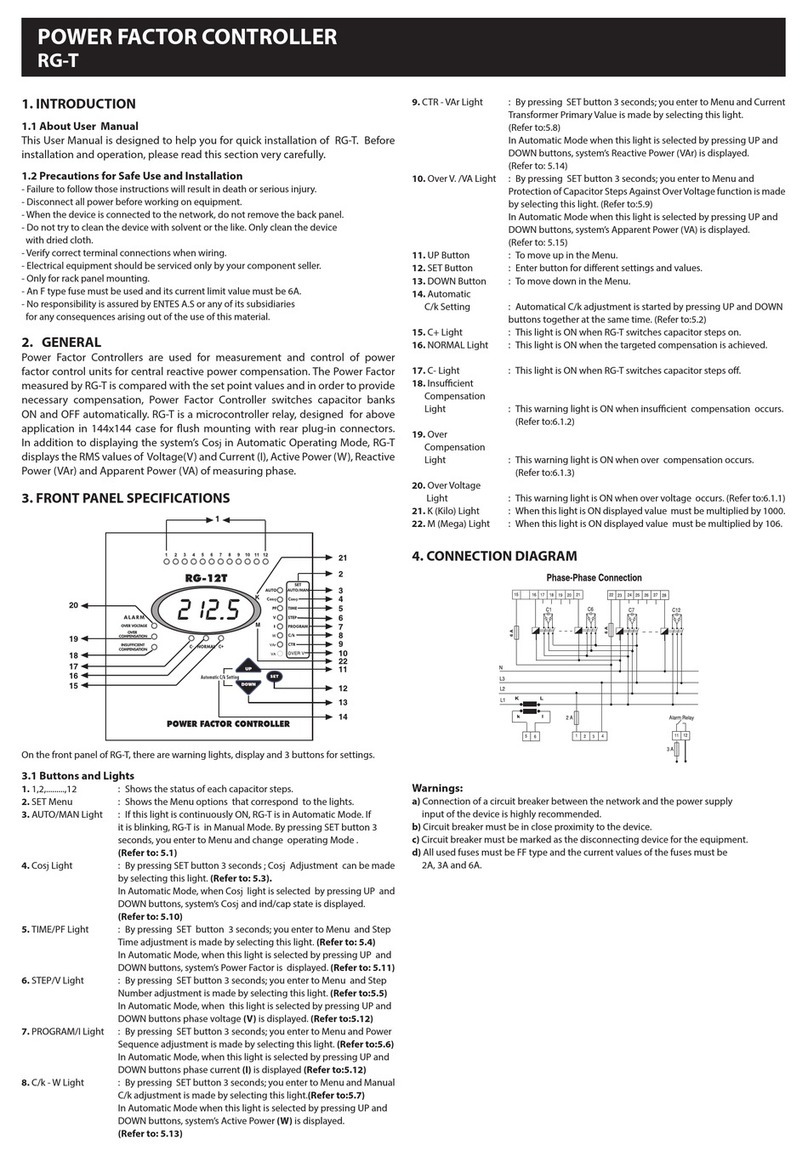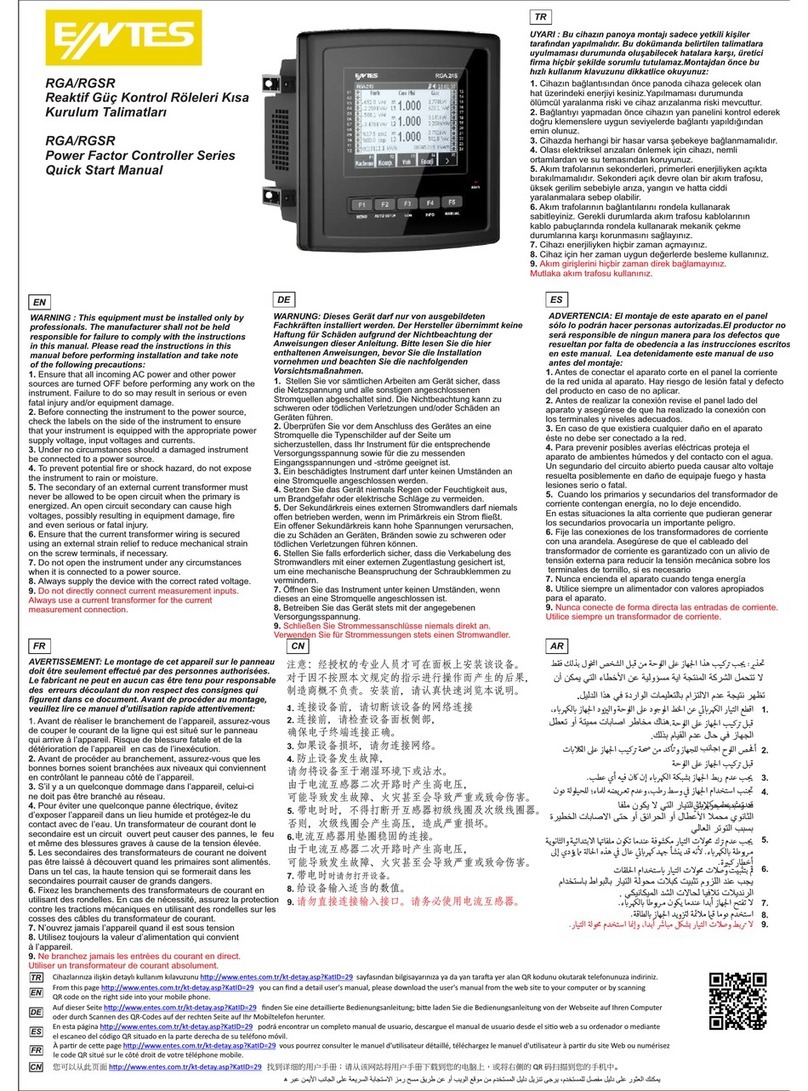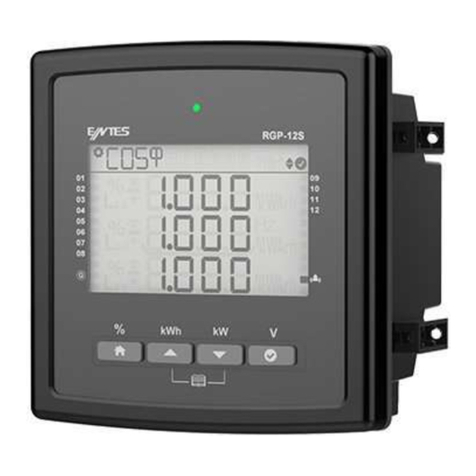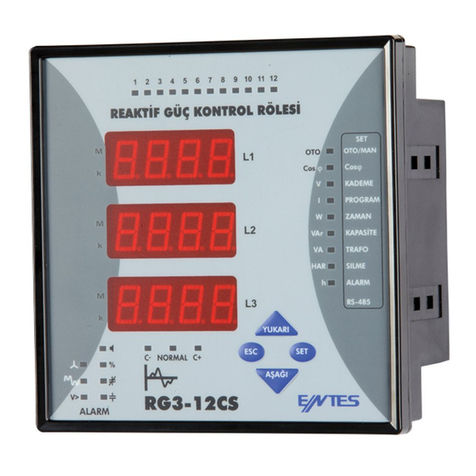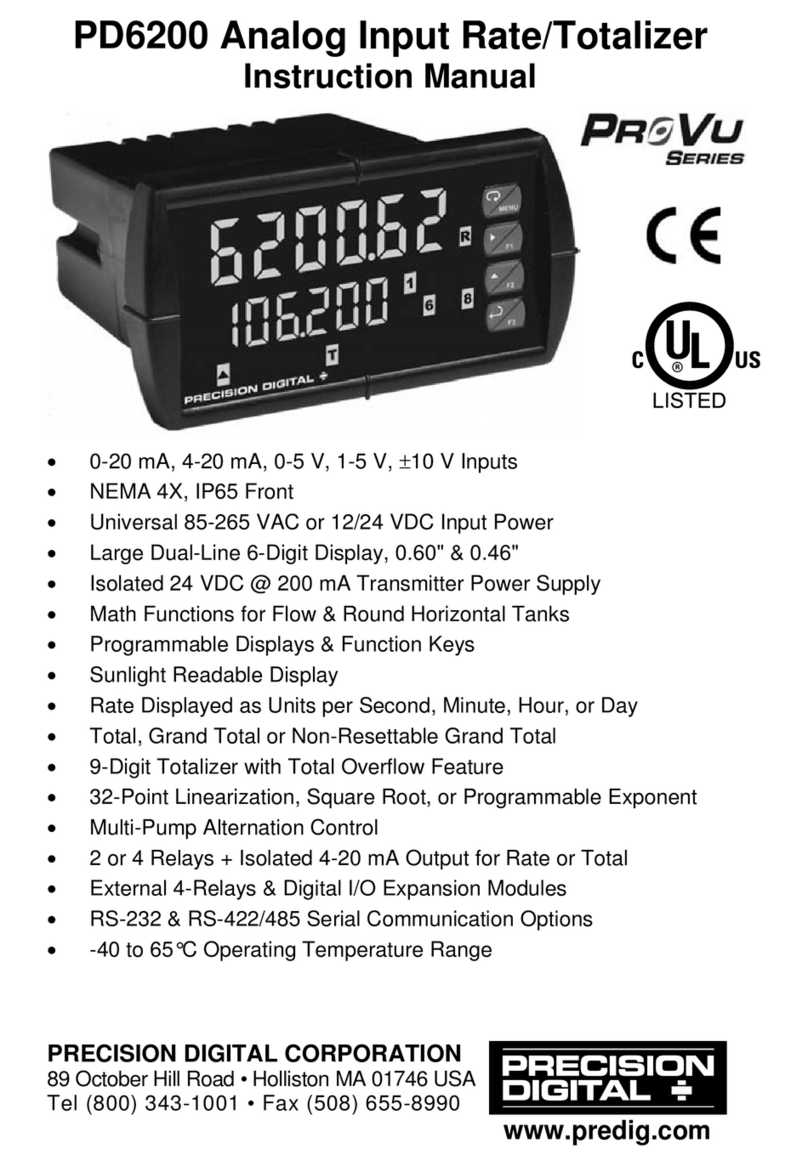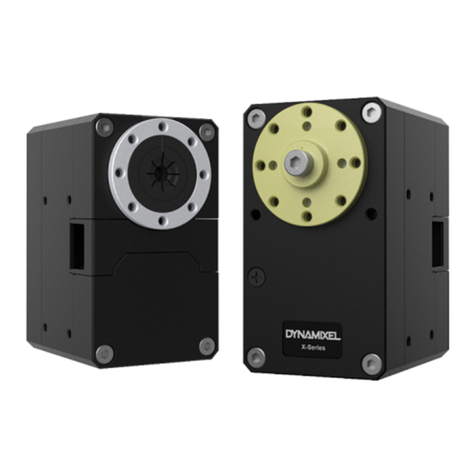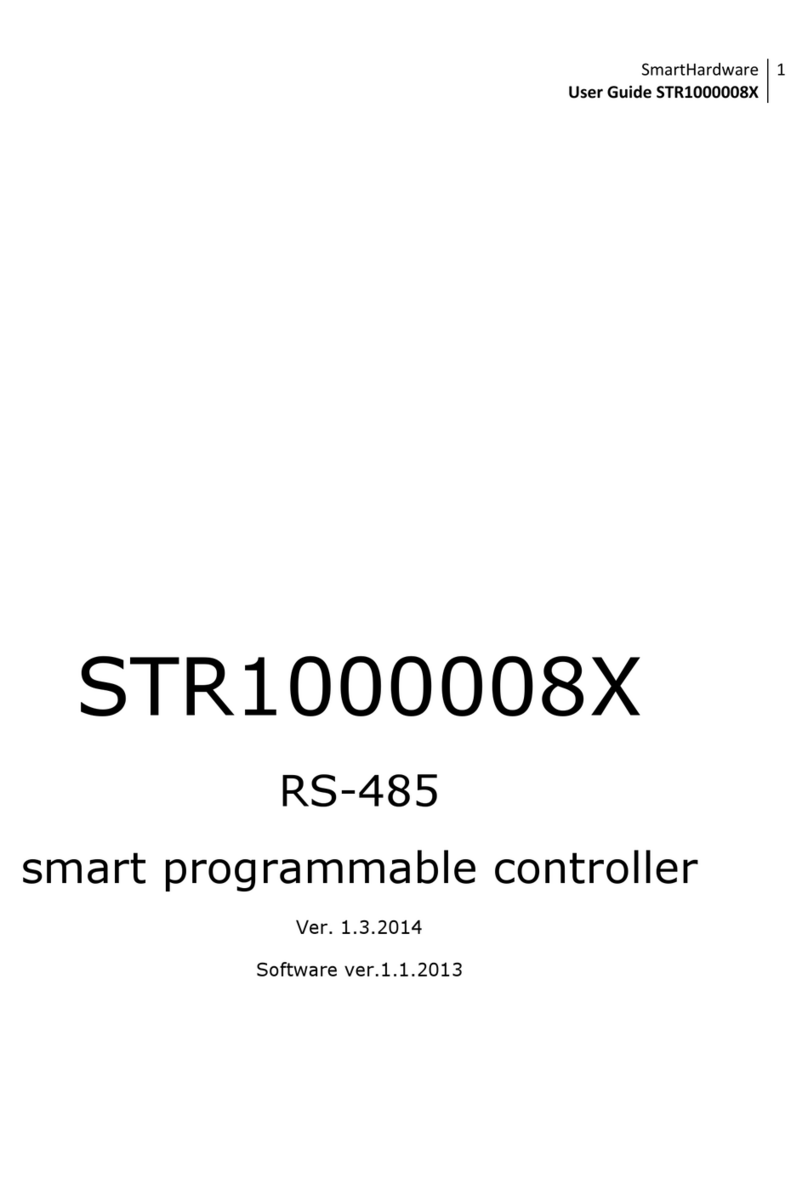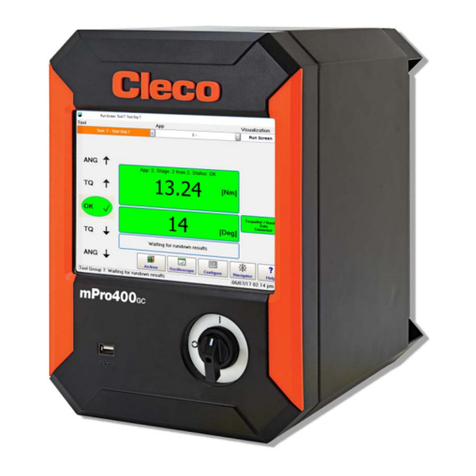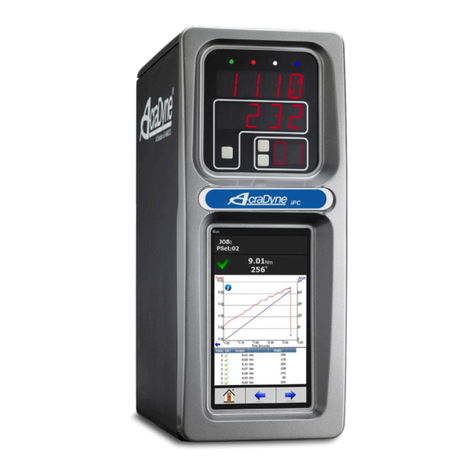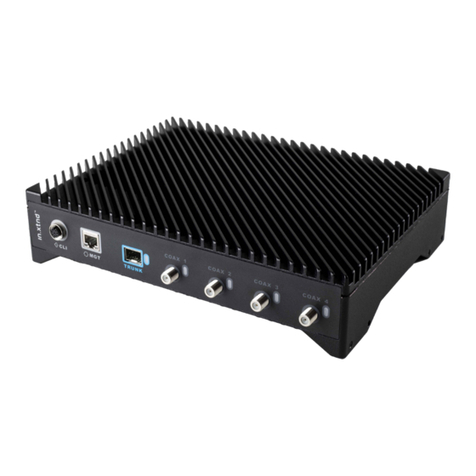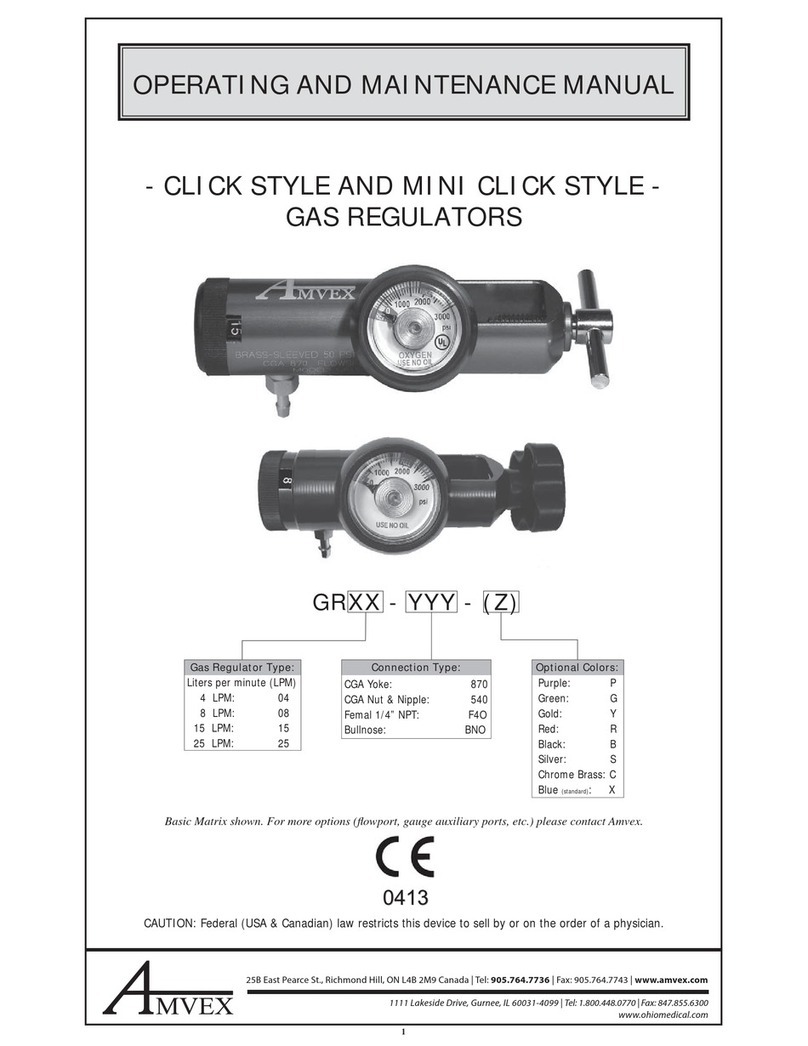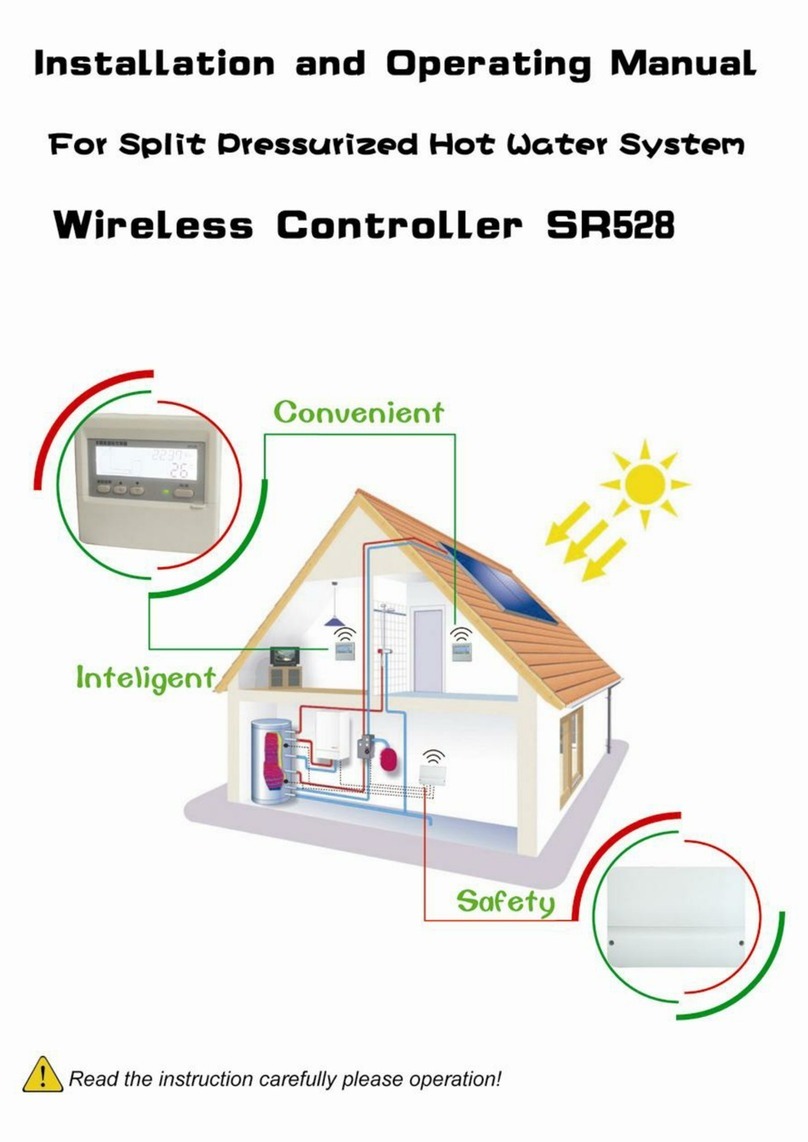Entes RG3-15C User manual

POWER FACTOR CONTROLLER
RG3-15C/CS/CL/CLS
SUMMARY
Precautions for Safe Use and Installation.......................................................................................................1
Important Note for System Connection .............................................................................................................1
1. INTRODUCTION ..........................................................................................................................................................................2
1.1 General Information ............................................................................................................................................2
1.2 Front Panel .................................................................................................................................................................2
1.3 Rear Panel ..............................................................................................................................................................4
2. INSTALLATION OF RG3-15C/CS/CL/CLS.....................................................................................................................5
2.1 Commissioning of RG3-15C/CS/CL/CLS ..........................................................................................................................5
2.2 Step Sequence Process ...........................................................................................................................................5
3. SETTINGS .................................................................................................................................................................5
3.1 Manual Operation, Automatic Capacitor Recognition Mode and Automatic Connection Recognition Mode...........6
3.2 Target Cos
j
and Cos
j2
Value Setting ....................................................................................................................7
3.3 Selection of Proper Switching Sequence.........................................................................................................................8
3.4 Switching on&off Time for Capacitor Steps and Discharge Time Settings.................................................................8
3.5 Power Value and Connection Type Settings for Capacitors ........................................................................................10
3.6 Current and Voltage Transformer Ratio Settings .......................................................................................................12
3.7 Reset Settings .....................................................................................................................................................14
3.8 Alarm Settings .....................................................................................................................................................15
3.9 Resetting the Energy Counters and Entering the Energy Values..................................................................................20
3.10 Computer Communication Settings .................................................................................................................................21
3.11 Password Activation and Change Settings .............................................................................................................23
4. DISPLAYING OF INSTANTANEOUS VALUES ......................................................................................................25
Cos
j,
Total Cos
j
, Voltages ................................................................................................................................25
Currents, Active Powers, Total Active Powers ...........................................................................................................26
Reactive Powers, Total Reactive Powers, Apparent Powers, Total Apparent Powers......................................27
Active Import Energy, Active Export Energy, Inductive Reactive Energy, Capacitive Reactive Energy,
Error Codes ......................................................................................................................................................28
5. APPENDIX .......................................................................................................................................................................29
Error Messages ................................................................................................................................................29
Register Table ..................................................................................................................................................30
Capacitor Calculation Table ............................................................................................................................................35
Technical Features ..............................................................................................................................................36
Menu Map .............................................................................................................................................................
A5372b/Rev.3

POWER FACTOR CONTROLLER
RG3-15C/CS/CL/CLS
1
Precautions for Safe Use and Installation
Consult the operating instructions before using the equipment. Following these precautions is a must for an error-
free operation and maintaining the eligibility for a warranty.
Therefore, please read this manual carefully before commissioning and using the RG3-12C/CS.
1)
2)
3)
4)
5)
6)
7)
8)
9)
10)
ATTENTION!
No responsibility is assured by the manufacturer or any of its subsidiaries for any consequences rising out of
disregarding these precautions while handling the RG3-12C/CS.
Important Note for System Connection.
First, connection type of auxiliary supply, voltage measurement and current measurement input must be 3 phase-
neutral. The device will not operate properly if these connections are not done.
A 3-phase capacitor must always be connected to the first step. At least 3 single phase capacitors must be connected
to the steps for RG3-15C/CS. Shunt reactors must be connected to R1, R2 and R3 steps for RG3-15CL/CLS.
1)
2)
Do not energise the device before verifying terminal connections.
Maintenance, installation and operation of RG3-12C/CS must be performed only by the qualified electricians.
Do not operate the device in undervoltage conditions.
Do not open the RG3-12C/CSs housing. There are no user servicable parts inside it.
RG3-12C/CS is connected to the network by means of a current transformer. Do not disconnect the current transformer
terminals. If you disconnect them, be sure to short-circuit the terminals or connect them to another parallel load which
has a low impedance. Otherwise, dangerously high voltage at the secondary side of current transformer may cause
an electric shock.
Do not use this product for any other purpose than its original task.
When device is connected to the network, do not remove the front panel.
Do not clean the device with solvent or similar items. Only clean with a dried cloth.
Verify terminal connections before commissioning.
Electrical equipment should be serviced only by your competent seller.
Device is only suitable for panel mounting.
Generator Input Connection
The connection to the generator input of the device must be done in a way that the energy comes to the system after the
generator connection to the network has been established. Otherwise, the device will switch to generator mode when the
generator is started for maintanence purposes.
If there is a voltage between 110-250 VAC present on the generator inputs of the device, the target Cosjset on the device
is deactivated and target Cosj2 is activated. Then the device starts the compensation according to target Cosj2. This
operation mode continues until the voltage on the generator input is disappeared.

1.2 Front Panel
On the front panel; 3 display lines with four digits which
consist of 7 segments, 4 buttons, alarm, capacitor step and
display LEDs exist. Measured parameters are observed in
the related displays. Displayed values for related parameters
are selected via indicator leds. When an alarm occurs,
related alarm LED blinks. 15 step LEDs indicate which step
is switched on. Detailled information about buttons, display,
alarm and capacitor step LEDs will be explained in the
coming sections.
POWER FACTOR CONTROLLER
RG3-15C/CS/CL/CLS
1. INTRODUCTION
1.1General Information
In todays world, the reactive loads on a network continue
to increase with the contracted power rise. The increase of
the power on transformers, transmission lines and generators
caused a rise in the reactive power levels just as much and
maybe more than the active power levels. To prevent any
overloads and under voltage conditions, the compensation
of the reactive loads became a necessity in todays energy
network.
Power factor controllers monitor the reactive power of a
plant and try to match the power factor value which is
defined as the ratio of the active power(W) to the apparent
power(VA) to a power factor valuewhich is defined on the
device by the user.
RG3-15C/CS/CL/CLS power factor controller is designed
for reactive power compensation in single phase and 3-
phase systems. RG3-15C/CS/CL/CLS compensates each
phase separately and so, this makes RG3-15C/CS/CL/CLS
series a unique solution for unbalanced load compensation.
In order to achieve this feat, single phase and 3-phase
capacitor steps must be connected to the device at the
same time.
RG3-15C/CS/CL/CLS ile Yapýlabilecek Ölçümler
Phase Voltage (L1,2,3-N) Measurement
Phase Current (L1,2,3-N) Measurement
Cos
j
Value (L1,2,3-N) Measurement
Average (Ind./Cap.) Cos
j
Value Measurement
Active Power (W), Reactive Power (VAr), Apparent Power
(VA) Measurement
Total Active Power (Ind./Cap.), Total Reactive Power
(Ind./Cap.), Total Apparent Power (Ind./Cap.)
Measurement
Active Energy (Wh-Import/Export), Reactive Energy
(VArh-Import/Export) Measurement
Measuring up to 19th Harmonic (V, I, W, VAr, VA) THD, 1,
3, 5, ..., 19
1)
2)
3)
4)
5)
6)
7)
8)
2
DIMENSIONS
Type PR16
(144x144)
143
99
121
138.4
143
18
34.5
67
1)Panel cut-out dimension must be 139 mm x 139 mm
(Type PR16).
2) Before installation, remove the mounting brackets.
3) Mount the device to the front panel.
4) Insert the mounting brackets.
5) Voltage and current terminals are designed for cables
with a cross-section of 2,5 mm2but these terminals are
suitable for cables with cross-sections up to 4 mm2.
6) CAT5 cable is recommended for RS-485 input terminal.
Excessive force can damage the device.
Turn the screw into the terminals and tighten until the
RG3-12C/CS is secured in place.
1.2.a Button Functions
UP
DOWN :
In the observation mode, they are used for
switching between observed parameters. In
the programming mode, they are used for
browsing the menu choices and changing
the parameter values.
In the observation mode, it is used to switch
between harmonic measurement mode and
instant value measurement mode. In the
programming mode, it is used to return to
the previous menu or exit without saving any
committed changes.
In the observation mode, it is used to show
the harmonic value of the measured
parameter. If it is pressed for 3 seconds,
programming mode appears. In the
programming mode, it is used to enter to a
menu or confirm the data entry.
ESC
SET
:
:
AUTO

1.2.b Front Panel Functions
POWER FACTOR CONTROLLER
RG3-15C/CS/CL/CLS
In order to enter to the menu, SET button
must be pressed for 3 seconds. In the following
sections, enter the menu means press the SET
button for 3 seconds.
3
2322 21
12
13
14
15
16
17
18
19
11
4
20
7
6
5
25
26
28
29
30
24
9
1
3
2
27
8
10
1. L1
2. L2
3. L3
4. Up Button
5. Esc Button
6. Set Button
7. Down Button
8. M LED
9. k LED
10. 1,2,3,... Step LEDs
11. SET Menu
12. OTO/MAN LED
13. CosjLED
:
:
:
:
:
:
:
:
:
:
:
:
:
Display for phase 1.
Display for phase 2.
Display for phase 3.
In the menu and measuring mode, is is used to
move upwards. In the setup mode, it is used to
increase the adjusted value.
In the menu, it is used to return to the previous
process or exit from a menu. In the measuring
mode, it is used to leave the harmonic
observation mode.
It is used to enter to the menu, to access a sub-
menu and save the committed changes. In the
measurement mode, it is used to monitor the
harmonic values of voltage, current and power
parameters.
In the menu and measuring mode, is is used to
move downwards. In the setup mode, it is used
to decrease the adjusted value.
It indicates that the measured value is in mega
units and the observed value is multiplied with
106.
It indicates that the measured value is in kilo
units and the observed value is multiplied with
103.
These LEDs indicate the state of corresponding
capacitor steps of the device. If a capacitor
step is activated, the corresponding step LED
is lit. Reactor step LEDs start to light up after
the 12th step LED on RG3-15CL/CLS models.
Programmable menus which are set by pressing
SET button for 3 seconds.
This LED indicates if the operating mode is
automatic or manual. If it is continuously on, the
device is operating in Automatic Mode. If it
blinks, the device is operating in Manual Mode.
The color of this LED is green.
If CosjLED is on in the menu, target Cosj
value can be set between Inductive 0,8 and
Capacitive 0,8. If CosjLED is on in the
measuring mode, Cosjvalues of related
phases are displayed.
14. PROGRAM / I LED
15. TIME / W LED
16. Capacitors/VAr LED
17. NETWORK/VA LED
18. RESET / HAR LED
19. ALARM / h LED
20. RS-485
21. C- LED
22. NORMAL LED
23. C+ LED
24.
25.
26.
27.
28.
29.
30.
:
:
:
:
:
:
:
:
:
:
:
:
:
:
:
:
:
If PROGRAM/I LED is on in the menu; the
switching sequence can be set in the menu. If
PROGRAM/I LED is on in the measuring mode,
the phase currents appear on their
corresponding phase displays.
If TIME/W LED is on in the menu; discharge
time, switch on delay time and switch off delay
time can be adjusted in the menu. If TIME/W
LED is on in the measuring mode, active power
and total active power (Imp./Exp.) values of the
phases are displayed on the corresponding
displays.
If CAPACITORS/VAr LED is on in the menu,
the power values and connection types(R, S,
T, RST) of the steps can be set. If
CAPACITORS/VAr LED is on in the measuring
mode, reactive power and total reactive power
(Ind./Cap.) values of the phases are displayed
on the corresponding displays.
If NETWORK/VA LED is on in the menu;
current transformer ratio (Ctr), voltage
transformer ratio (Vtr) and calculation method
(Calc) can be set. If NETWORK/VA LED is on
in the measuring mode, apparent power and
and total apparent power values of the phases
are displayed on the corresponding phase
displays.
Press SET button for 3 seconds and enter the
menu. Select the RESET/HAR LED to erase
the energy values, reset the reactive energy
ratios and alarms.
Press SET button for 3 seconds and enter the
menu. Select ALARM/h LED to set the
boundary values for alarms(overvoltage,
reactive/active ratio and harmonics).
In this menu; settings related to the RS-485
communication protocol(baudrate, address,
parity) are set.
This LED indicates that RG3-15C/CS/CL/CLS is
waiting to switch off capacitor steps.
This LED indicates that RG3-15C/CS/CL/CLS
will not switch any capacitor steps on or off.
This LED indicates that RG3-15C/CS/CL/CLS is
waiting to switch on capacitor steps.
Incase of a failure, alarm relay switches on and
alarm LED lights up.
In case of a connection failure, this LED lights
up.
If reactive energy ratios go beyond user-defined
values, this LED lights up.
If voltage harmonic ratios go beyond user-
defined values, this LED lights up.
When target Cosjvalue is not reached even
though all of the capacitor steps are switched
on(insufficient step power for target
compensation), this LED lights up.
If there isnt a capacitor connected to a step,
capacitor step failure LED lights up.
If the voltage value exceeds the user-defined
overvoltage, this LEDC lights up.
AUTO

POWER FACTOR CONTROLLER
RG3-15C/CS/CL/CLS
1.3 Rear Panel
4
CONNECTION DIAGRAM
* Current value of 3-Phase fuses, which are connected to protect the capacitors, must be chosen according to the nominal current value of
capacitors which are given by the manufacturer.
Dont energise the device without making sure that the connections are correct. A 3-phase capacitor must always be connected to the first
step. Shunt reactors must be connected to R1, R2 and R3 steps for RG3-15CL/CLS.
15 16 17 18 19 20 21
5 6 7 8 9 10
6A
6A
11 12
22 23 24 25 26 27 28
2A 2A 2A
k1k2l2k3l3l1
N
L3
L2
L1
13 14
1 2 3 4
L1 L2 L3 N
33 34 35 36
6A
K L
l1k1
K L
l2k2
K L
l3k3
Alarm
Relay
Generator
Input
110~250 V AC
C12C11C10C9C8C7C5C4C3C2C1
C13 C14 C15
C6
RG3-15C/CS
* Current value of 3-Phase fuses, which are connected to protect the capacitors, must be chosen according to the nominal current value of
capacitors which are given by the manufacturer.
Dont energise the device without making sure that the connections are correct. A 3-phase capacitor must always be connected to the first
step.
At least 3 single phase capacitors must be connected to the steps for RG3-15C/CS.
15 16 17 18 19 20 21
5 6 7 8 9 10
6A
6A
11 12
22 23 24 25 26 27 28
2A 2A 2A
k1k2l2k3l3l1
29 30 31 32
N
L3
L2
L1
13 14
1 2 3 4
L1 L2 L3 N
33 34 35 36
6A
K L
l1k1
K L
l2k2
K L
l3k3
Alarm
Relay
Generator
Input
110~250 V AC
RG3-15CL/CLS
C12C11C10C9C8C7C5C4C3C2C1
R1 R2 R3
C6TR B GNDA
RS485

POWER FACTOR CONTROLLER
RG3-15C/CS/CL/CLS
2. INSTALLATION OF RG3-15C/CS/CL/CLS
For proper operation of RG3-15C/CS/CL/CLS; 3-Phase, neutral,
voltage and current terminals must be connected as shown in the connection
diagram. Device will not be able to operate properly without 3-phase
connection.
After the connection of the current and voltage lines, connect the
capacitors to the device. The most important point is connecting a 3-phase
capacitor to the first step
. At least 3 single phase capacitors must be
connected to steps for RG3-15 C/CS. Shunt reactors must be connected
to R1, R2 and R3 steps for RG3-15 CL/CLS.
Shunt reactors for RG3-15 CL/CLS must have power values equal to or less
than capacitor power values.
Finally, communication connection must be done.
Do not energise the device before verifying the connections
.
Always connect a 3-phase capacitor to the 1st step.
5
* Current value of 3-Phase fuses, which are connected to
protect the capacitors, must be chosen according to the
nominal current value of capacitors which are given by the
manufacturer.
Warnings:
Firstof all; connection type of auxiliary supply, voltage measurement
and current measurement input must be 3 phase-neutral. The device
will not operate if these connections are not done.
After the device is energized, it finds connection errors and corrects
automatically as the first operation. Phase current should not be equal
to zero in order to let the device to detect the connection error.
Device detects the connection error according to Active Power direction.
Device switches ON and OFF the 1st steps 3-phase capacitor during
the correction of connection errors (Phase sequence error and polarity
error of Current Transformer). Device may not correct the connection
errors if there are too many instant variations for loads and nonlinear
loads (Such as Thyristor or triac controlled frequency inverter, UPS etc.).
In this case, user should disconnect the device and restart it to make
the same operation. This feature also can also be operated with turning
ON the Auto SET function in Auto menu. In this case device corrects
the errors and then calculates the capacitor values.
After connection errors are corrected; capacitor steps are calculated
by turning the Auto Setup function ON in Auto menu (Refer to
Automatic Capacitor Recognition menu). A 3-phase capacitor
has to be connected to 1st step of the device. At least 3 single
phase capacitors must be connected to the steps for RG3-
15C/CS. Shunt reactors must be connected to R1, R2 and R3
steps for RG3-15CL/CLS. Inductive reactor step powers cant
be calculated automatically for RG3-15CL/CLS. Power values
must be entered manually. All steps are measured seperately if
the program-10 (PS-10) is selected in Program menu. In this
program (PS-10); single or 3-Phase capacitors can be connected
according to requirements of the system in any order. If you let the
device calculate the step power values in the previous step, you
can skip this part.If one of the other programs is chosen, device
measures the 1st steps power value and then calculates the other
steps values according to 1st steps value.
Device calculates the capacitor values which will be switched ON
according to selected program and switches ON or OFF the
necessary steps.
Connection of a circuit breaker or an automatic fuse is highly
recommended between the network and RG3-12C/CS. This circuit
breaker must be marked in order to seperate them from other
breakers.
All fuses which are used must be FF type and the current values
of the fuses must be 2A or 3A and 6A (Refer to Connection
Diagram).
The connection to the generator input of the device must be done
in a way that the energy comes to the system after the generator
connection to the network has been established. Otherwise, the
device will be switched to the generator operation for any generator
starts including the ones for maintaining purposes.
a)
b)
c)
After the device is energised, it finds connection errors and corrects
them automatically. Power values of the capacitor steps are measured
automatically according to program selection. If PS-10 program is
selected, power values of all capacitor steps are measured (Refer to
Program Section). If any other program is selected, device measures
first capacitor step value and then calculates other capacitor steps
according to the selected program. For this reason, a 3-phase capacitor
must be connected to the first step
. Shunt reactors must be connected
to R1, R2 and R3 steps for RG3-15 CL/CLS.
After the device calculates
and saves the capacitor values, it will switch them on and off when
needed
.
When the capacitive steps are switched on, three-phase or single-phase
inductive steps dont switch on.
When the single-phase inductive step is switched on, capacitive steps on
other phases may be switched on. For example; when inductive load on
T phase is switched on, capacitive loads on R or S phases may switch on.
2.1 Commissioning of RG3-15C/CS/CL/CLS
2.2 Sequencing of Steps
3. SETTINGS
3.1.a Manuel Operation Mode Setting
Device has two operating modes which are automatic and manual. The
operation mode is choosed by selecting the Auto Operati option as
on(automatic mode) or off(manual mode). Manual mode is used for test
purposes. In this mode, capacitor steps are switched on&off to test relay
outputs. In manual mode, capacitor steps are switched on with SET
button and switched off with ESC button. The conditions of the steps
can be monitored from the 15 step LEDs on the front panel. C+ LED lights
up when a step is switching on and C- LED lights up when a step is switching
off. Factory set values for switching on (t-on) and switching off (t-of) time
are 10 sec. These values can be changed by the dELy menu (Refer to
Switching on&off Time for Capacitor Steps and Discharge Time Settings).
In manual mode; step numbers, which will be switched on&off, can be
programmed in StEP menu (Refer to Step Number Setting). Even if manual
mode is selected, device switches to automatic mode after 5 minutes
continues to operate in this mode.
When automatic mode is selected, AUTO/MAN LED lights up continuously.
When manual mode is selected, AUTO/MAN LED blinks.
Warning: Device warns user by blinking (short ON, long OFF) the LED
of the capacitor steps which will be switched on. Also device warns
user by blinking (long ON, short OFF) the LED of the capacitor steps
which will be switched off.
3.1 Manual Operation Mode, Automatic Capacitor
Recognition Mode and Automatic Connection Control
Mode
When RG3-15C/CS/CL/CLS is energised for the first time, if the
power value of any phase is negative, it switches the first capacitor step
on&off automatically to recognize the connection error and records the
connections.
Later, automatic setup (Refer to page 6 - Automatic setup) is selected
from the menu in order to recognise the connections and connected steps
automatically. Inductive load steps cant be calculated automatically for
RG3-15CL/CLS model. Power values have to be entered manually.
After automatic recognition, RG3-15C/CS/CL/CLS checks all
capacitor step values. If variable loads exist in the system, these variable
loads must be disconnected first and then automatic setup process must
be done. Otherwise, power factor controller may not measure capacitor
step powers correctly. Capacitor step powers and connection types also
can be entered to the power factor controller manually.
(Refer to page 10 - Setting of the capacitors connection and power values
)
After recognising the capacitor step powers, target Cosj
value is set in order to start the compensation. Factory set value for target
Cosjis ind. 1.000 and Cosj2 is ind. 0.900.
NOTE: PFC decreases the switching on&off time to 3 seconds in
Automatic Setup mode but discharge time is not changed. After the
automatic setup process, set values become valid.
d)
e)
f)

When the device is energised for the first time, it checks for connection
errors. If there is a faulty connection, it corrects this fault in itself. In order
for the device to correct a connection fault, 3-phase voltage and current
connections of the device must be done.
NOTE: If there are other loads than compensation connected to the
system, the device may not find the connection at the first try and may
need several tries. However, if the device is unable to complete the
automatic connection process step calculation process shouldnt be
done.
In order for the calculated capacitor powers to be accurate, the
current and voltage transformer ratios have to be entered correctly
before the automatic capacitor recognition process. If these ratios are
not entered by the user, they will be set as 1 by the device and the
capacitor step powers will be calculated according to these values(Refer
to page 12-CT and VT Ratio Settings).
After any connection faults are corrected by the device; if Auto Setup
option is set as on, the device calculates the capacitor step powers
according to the selected program. If 10th program(P-10) is selected , all
of the capacitor step powers are measured seperately. If any other program
is selected, the device measures only the first capacitor step power and
then calculates the other step powers according to the selected
program
(Refer to page 7-Step Number Setting).
NOTE: If the option on is selected in the automatic setup menu, the
automatic capacitor recognition will start without exiting the menu.
The step powers which are calculated after this process must always
be checked.
Inductive load step powers cant be calculated automatically for RG3-
15CL/CLS. Power values have to be entered manually.
Press UP or DOWN button
to select.
POWER FACTOR CONTROLLER
RG3-15C/CS/CL/CLS
3.1.b Automatic Capacitor Recognition Mode Setting
6
Press the SET button for 3 s in order to enter the menu.
Select on or of using the UP and
DOWN buttons(Select on for automatic
capacitor recognition).
Press SET button to set the parameters in Auto menu option.
To select the automatic operating mode, choose on with UP
or DOWN buttons and press SET button. To select the manual
operating mode, choose oF with UP or DOWN buttons and
press SET button.
The first setting in this menu is the operation mode(Operati). The
operation mode of the device is selected according to this options
on or off selection. Press SET button to change this setting.
In Auto Operatý menu, choose Auto Setup menu by pressing
the UP button.
The 2nd setting in this menu is the Auto Setup setting. The
automatic setup will or will not start according the options on
or off selection. To change this setting, press the SET button.
Numerical values of the parameters are set via buttons in
the display. The blinking digit indicates which digit will be
set. Numerical value of the related digit is increased or
decreased via UP or DOWN button. To set the next
digit, SET button is used. To go back to the previous
digit, ESC button is used.

POWER FACTOR CONTROLLER
RG3-15C/CS/CL/CLS
7
3.2 Target Cosjand Target Cosj2 Value Settings
3.2.a Inductive / Capacitive Cosj and Cosj2 Setting
Press the SET button for 3 s in order to enter the menu.
Using the DOWN / UP buttons, find the Target Cosj(COS or
COS2) menu option.
Press SET button to enter Target Cosjsetting.
Using the UP/DOWN buttons, enter a Cosjvalue between -
0,800 ... 0,800 and press the SET button.
Using the UP/DOWN buttons, enter to another menu option
which you wish to change. If you are not going to change any
more settings, press the ESC button.
SAUE
If you want to leave the setup menu without making any other
changes, press the ESC button until SAVE SEt yES shows
on the screen. If you want to save the changes, press the SET
button. If not, press the ESC button.
3.1.c Automatic Connection Recognition Mode
Setting
This option is used for activating or deactivating the connection
recognition mode when the device is energised. It is activated as
factory default. In applications with a generator, the voltage and
current information may not arrive to the device properly depending
on the transfer panels design and delay when the system is switched
from generator to the network power. When this transition occurs,
the device may find a connection fault. Therefore, it is recommended
to turn this option off after the setup is completed.
Select the Auto Setup option in the Auto Operatý menu with
DOWN button.
Connection correction is activated or deactivated depending on
the on or off position of the Auto connection option. To change
this setting press the SET button.
When Auto connection is on, the device controls its connection
automatically at start-up and corrects any existing measurement
input errors. If this option is of, automatic connection correction
is deactivated. Using UP or DOWN buttons, select on
orof.
SAUE
If you want to leave the setup menu without making any other
changes, press the ESC button until SAVE SEt yES shows
on the screen. If you want to save the changes, press the SET
button. If not, press the ESC button.
The device has two target Cosj values as Cosj ve Cosj2.
If there is a voltage between 110-250 VAC present on the generator inputs
of the device, the target Cosj set on the device is deactivated and target
Cosj2 is activated. Then the device starts the compensation according to
target Cosj2. This operation mode continues until the voltage on the generator
input is disappeared.
Target Cosjve Cosj2 values may be adjusted between 0,800 ... -0,800 by
the user. Negatif values represent Capacitive region and positive values represent
Inductive region. RG3-15C/CS/CL/CLS tries to match the systems Cosjto the
user defined value. If the need for compensation of a phase is lower than 0,625
times of the capacitor which is connected to that phase, the device doesnt activate
or deactivate any steps and stays at NORMAL status
. If there arent any connected
capacitors on that phase, the device operates according to one-third(the power
for that phase) of the 3-phase capacitor with the lowest power value.
Target Cosjand Cosj2 values may be entered between 0,800 ... -0,800.
Negative value represents Capacitive, positive value represents Ýnductive region.
NOTE : Cosj2 value can be set the same way from Cosj2 menu.

POWER FACTOR CONTROLLER
RG3-15C/CS/CL/CLS
8
3.3 Selection of Proper Switching Sequence
There are 10 different program modes which determines the power ratio
sequence of the capacitor steps. The switching programs are given in the
table. If the step sequence is selected as in program 02(PS-02), many
identical connection components must be used. When a step sequence
between the 3rd and the 8th one is selected, less identical connection
components will be used. By selecting the 9th connection sequence,
different group powers can be achieved. In this sequence connection, the
rating of each capacitor step value may exceed that of the first by a
maximum amount equal to the preceding capacitor steps value. By
using this setting, less capacitors will be used. When the 10th connection
sequence is selected, RG3-15C/CS/CL/CLS will calculate the capacitor
step power values automatically.RG3-12C/CS/CL/CLS counts swithing
on&off times of all capacitor steps and so only the most necessary step
is switched on. Thus, maximum service life time of the system is
ensured.
NOTE: In the 10th program(PS-10), power values and
connection types(except the first step) of the single phase
capacitor steps(r, s, t, rst, oFF) can be set by user. In Auto
setup mode power values of all capacitor steps are measured
and connection types of the capacitor steps are detected
by the device. In all the connection sequences except the
10th one, only the 1st capacitor step power can be set. All
the other capacitor step values are calculated according to
the 1st capacitor steps power value.
Set the program option suitable for your system in this menu
.
Press the SET button for 3 s in order to enter the menu.
Using the UP/DOWN buttons, select the Program (Prog) menu.
When program menu is displayed, program LED turns on.
SAUE
If you want to leave the setup menu without making any other
changes, press the ESC button until SAVE SEt yES shows
on the screen. If you want to save the changes, press the SET
button. If not, press the ESC button.
Press the SET button to select the switching program.
Enter the desired program number between 01-10 and press the
SET button.
Using the UP/DOWN buttons, enter to another menu option
which you wish to change. If you are not going to change any
more settings, press the ESC button.
Press the SET button for 3 s in order to enter the menu.
PROGRAM SEQUENCE
01
02
03
04
05
06
07
08
09
*10
linear
1.1.1.1................
1.1.2.2................
1.2.2.2................
1.2.3.3................
1.2.4.4.................
1.1.2.4................
1.2.3.4................
1.2.4.8................
Capacitor step values are calculated automatically.
* Recommended switching program.
In order to decrease harmful effects of instant reactive power loads to the
relays and capacitors, delay time (in terms of seconds) for capacitor steps
is entered in this menu.
Switch-on delay time must be set according to system requirement in
order to achieve compensation targets and also to provide long life time
for contactors and capacitors.
3.4.a Switch-On Delay Time Setting
NOTE: t-on and t-of time periods must be set according to your systems
requirements. If t-on time is set very long, relay can not switch on until
the end of this time period and so target compensation ratios may not
be achieved. If t-on time is set too short, capacitor steps switch on&off
frequently in case of fast load variations and this will shorten the life
time of contactors and capacitors. For this reason, it is very important
to set these time periods according to your systems requirement.
Using the UP/DOWN buttons, select the delay time menu
(dELy).
When delay time menu is displayed, time LED turns on.
3.4 Switching On&Off and Discharge Time Settings

POWER FACTOR CONTROLLER
RG3-15C/CS/CL/CLS
9
3.4.b Switch-Off Delay Time Setting
SAUE
Switch-off delay time must be set according to system requirement in
order to achieve compensation targets and also to provide long life time
for contactors and capacitors.
Using the UP/DOWN buttons, select the switch-off delay time
(dELy t-oF) menu.
The second setting in this menu is the switch off delay time setting
(t-of). Press theSET button to change this time value.
SAUE
If you want to leave the setup menu without making any other
changes, press the ESC button until SAVE SEt yES shows
on the screen. If you want to save the changes, press the SET
button. If not, press the ESC button.
Enter a value between 1-1800 seconds and then press SET
button. Using the UP/DOWN buttons, enter to another menu
option which you wish to change. If you are not going to change
any more settings, press the ESC button.
Press the SET button to enter delay time settings menu(dELy).
The first setting in this menu is the switch on delay time setting(t-
on). Press theSET button to change this time value.
Enter a value between 1-1800 seconds and then press SET
button. Using the UP/DOWN buttons, enter to another menu
option which you wish to change. If you are not going to change
any more settings, press the ESC button.
If you want to leave the setup menu without making any other
changes, press the ESC button until SAVE SEt yES shows
on the screen. If you want to save the changes, press the SET
button. If not, press the ESC button.

POWER FACTOR CONTROLLER
RG3-15C/CS/CL/CLS
10
Discharge time must be set according to determined time periods by the
capacitor suppliers. If discharge coil or contactors, which have discharge
coils, are used, discharge time can be shorten according to do instructions
defined by the suppliers.
3.4.c Discharge Time Setting
Using the UP/DOWN buttons, select the discharge time menu
(dELy t-rC).
The third setting in this menu is the switch off delay time setting
(t-rC). Press theSET button to change this time value.
Enter a value between 1-1800 seconds and then press SET
button. Using the UP/DOWN buttons, enter to another menu
option which you wish to change. If you are not going to change
any more settings, press the ESC button.
SAUE
If you want to leave the setup menu without making any other
changes, press the ESC button until SAVE SEt yES shows
on the screen. If you want to save the changes, press the SET
button. If not, press the ESC button.
3.5.a First Capacitor Step Setting
First capacitor step is used to find connection. Therefore, a 3-phase capacitor
must be connected to the first step. For this reason, it isnt possible to set
the connection setting for first capacitor step and it is always selected RST
type.
When setup parameter is selected as on in Auto menu, if any program
except PS-10 is selected, power value of the first capacitor step is measured
and other steps power values are calculated according to selected program.
Note : When setup parameter is selected as on in Auto menu, after
completing the measurement of capacitor powers according to the
selected program, RG3-12C/CS continues to work in setup:of mode.
In this menu, power values and connection types of all capacitor steps can
be set.
There are 5 different connection types for capacitors which are R, S, T,
RST and off. Also capacitor step measurement for power values can be
set between 0,020-2,000 kVAr. If a capacitor step is set as off, there is
no need to set any power value.
Note : For the first capacitor step. There isnt a connection type setting.
RST connection type always must be selected because first capacitor
step is used to detect correct connection.
Note : If the 10th program is selected, capacitor powers can be set
separately for each capacitor step. However; if any program except
PS-10 is selected, only first capacitor steps power value (C-01) can be
set manually. Capacitor powers for other steps are calculated in 3-
phase according to the selected program.
3.5 Power Value and Connection Type Settings
for Capacitors
Press the SET button for 3 s in order to enter the menu.
Using the UP/DOWN buttons, select Step menu where capacitor
connection and power values will be entered. When Step menu
is displayed, step (VAr/STEP) LED turns on.
Press the SET button to enter capacitor (CAP) settings menu.
Sep

POWER FACTOR CONTROLLER
RG3-15C/CS/CL/CLS
11
Press the SET button to enter to the first capacitor step
setting menu(C-01) which is the first menu under the capacitor
menu option.
First capacitor step is used to find connection. Therefore, a 3-phase
capacitor must be connected to the first step. For this reason, it isnt
possible to set the connection setting for first capacitor step and it is
always selected RST type and it can not be changed. Press the SET
button to set power value of the first capacitor step.
Enter the power value of the first capacitor step and then press
the SET button. If you are going to change another setting,
enter the desired menu option by using UP/DOWN buttons. If
you do not want to set another parameter, press the ESC button.
NOTE: If the 10th program is selected, capacitor powers can
be set separately for each capacitor step. However; if any
program except PS-10 is selected, only first capacitor steps
power value (C-01) can be set manually. Capacitor powers for
other steps are calculated in 3-phase according to the selected
program..
SAUE
If you want to leave the setup menu without making any other changes,
press the ESC button until SAVE SEt yES shows on the screen. If
you want to save the changes, press the SET button. If not, press the
ESC button.
When PS-10 (Program 10) is selected, connection type and capacitor power
value settings of all capacitor steps from the 2nd to the 15th can be set.
When a program expect PS-10 is selected, only first capacitor steps setting
can be changed and other steps can not be set.
Using the UP/DOWN buttons, second capacitor steps connection
type can be set manually as connected to the r, S, t or
rSt phase/phases. If this parameter is selected as oFF,
capacitor step which is connected to the second step will be
disabled.
Note:
After automatic calculation of the capacitors, if oFF
is displayed in any step, it means that related capacitor could
not be calculated, is defected or there is no connected
capacitors in the related step
Press the SET button to set second capacitor steps power value.
3.5.b Second Step Capacitor Setting
Using the UP/DOWN buttons, find the second capacitor step setting
menu(C-02).
The first setting in this menu is the connection type. Press theSET
button to set the connection type.
2
Enter the power value of the second capacitor step and then press
the SET button. If you are going to change another setting,
enter the desired menu option by using UP/DOWN buttons. If
you do not want to set another parameter, press the ESC button.

POWER FACTOR CONTROLLER
RG3-15C/CS/CL/CLS
12
2
SAUE
If you want to leave the setup menu without making any other
changes, press the ESC button until SAVE SEt yES shows
on the screen. If you want to save the changes, press the SET
button. If not, press the ESC button.
Enter the power value of the second capacitor step and then press
the SET button. If you are going to change another setting,
enter the desired menu option by using UP/DOWN buttons. If
you do not want to set another parameter, press the ESC button.
Above step settings for connection type and power value can be done
just like second capacitor step setting (C-02).
CAP C-03
In this menu, capacitor setting for 3rd step are done.
CAP C-04
In this menu, capacitor setting for 4th step are done.
..................
..................
..................
CAP C-13
In this menu, capacitor setting for 13th step are done.
CAP C-14
In this menu, capacitor setting for 14th step are done.
CAP C-15
In this menu, capacitor setting for 15th step are done.
* IND R-1
In this menu, settings for shunt reactor which is connected to R1 step are done.
* IND R-2
In this menu, settings for shunt reactor which is connected to R2 step are done.
* IND R-3
In this menu, settings for shunt reactor which is connected to R3 step are done.
*Valid for RG3-15CL/CLS.
In this menu, current transformer ratio can be set between 1-2000.
For Example: For a 150/5 current transformer, CT ratio must be set as 30.
NOTE: Be aware that this value is entered as a ratio, not CT primary
or secondary value.
3.6.a Current Transformer Ratio Setting
To obtain accurate power values when calculating the capacitor step
powers, current and voltage transformer ratios must be entered correctly.
If these ratios are entered incorrectly, the calculated capacitor step powers
will be incorrect. When these ratios arent entered, the device will set these
ratios as 1 and capacitor step powers will be calculated according to
this setting.
Current and voltage transformer ratios can be set separately.
3.6
Current and Voltage Transformer Ratio Settings
Steps which will not be used can be deactivated by selecting off in the
step menu. After these settings are done, the device must deenergised
and reenergised. If the device is not reset, unselected steps may stay
activated and they may not be deactivated in case they are activated.
NOTE: Since connection type of the free capacitor steps (without a
capacitor bank connected to them) can be set as oFF when Program
10 is selected, their activation or deactivation dont come into question.
This setting must be used for power sequencing options other than
Program 10.
When you set the 11th capacitor step oFF by using UP/DOWN
buttons, the capacitor group which is connected to the 11th step
will be deactivated.
Note: After automatic calculation of the capacitors, if oFF
is displayed in any step, it means that related capacitor could
not be calculated, is defected or there is no connected
capacitors in the related step.
3.5.c Step Number Setting
Find C-11 menu option where connection type and step power
value will be set by using UP / DOWN buttons.
The first setting in this menu is the connection type. Press theSET
button to set the connection type.

POWER FACTOR CONTROLLER
RG3-15C/CS/CL/CLS
13
Using the UP/DOWN buttons, find current and voltage
transformer ratio menu (trF). When this menu is selected,
Transformer (VA/TRF) LED turns on.
Press the SET button for 3 s in order to enter the menu.
Press the SET button to enter to the CT and VT ratio setting
menu.
The first setting in the CT and VT ratio menu is the CT ratio menu.
Press the SET button to set CT ratio.
Enter CT ratio between 1-2000 and press the SET button.
If you
do not want to set another parameter, press the ESC button. If
you are going to change another setting, enter the desired menu
option by using UP/DOWN buttons. If you do not want to set
another parameter, press the ESC button.
SAUE
If you want to leave the setup menu without making any other
changes, press the ESC button until SAVE SEt yES shows
on the screen. If you want to save the changes, press the SET
button. If not, press the ESC button.
In this menu, voltage transformer ratio can be set between 1-2000.
For Example: For a 34,5 kV / 100 V transformer, VT ratio must be set as 345.
NOTE: Be aware that this value is entered as a ratio, not VT primary
or secondary value.
3.6.b Voltage Transformer Ratio Setting
Using the UP/DOWN buttons, enter the voltage transformer
ratio (Vtr) menu which is the second menu in CT and VT ratio
settings.
Press the SET button to set VT ratio.
Enter VT ratio between 1-2000 and press the SET button.
If
you do not want to set another parameter, press the ESC button.
If you are going to change another setting, enter the desired menu
option by using UP/DOWN buttons. If you do not want to set
another parameter, press the ESC button.
SAUE
If you want to leave the setup menu without making any other
changes, press the ESC button until SAVE SEt yES shows
on the screen. If you want to save the changes, press the SET
button. If not, press the ESC button.

POWER FACTOR CONTROLLER
RG3-15C/CS/CL/CLS
14
Make a selection by using UP/DOWN buttons.
In this menu; alarms and ratios(reactive/active ratios) are reset.
The alarms which occur when the device operates are reset in this menu.
To reset the alarms, yES option must be selected.
NOTE: When an alarm occurs, the alarm relay switches on and the
related alarms LED turns on and the alarm code is displayed. Even if
alarm conditions disappear, the alarm relay will stay switched on. By
using the reset menu, alarms are reset and alarm relay is switched off.
If alarm conditions still exist, even if alarms are reset in the reset
menu, alarm relay switches on again. If alarm conditions disappeared,
alarm relay continues to its normal operation.
3.7.a Alarm Reset Operation Setting
3.7 Reset Operation Settings
Using the UP/DOWN buttons, find the reset menu option(rESEt).
When reset menu is selected, Reset LED turns on.
Press the SET button to enter reset (rESEt) setting options.
Press the SET button to set the alarm (ALAr) setting which is
the first setting in the reset (rESEt) menu.
Select yES with AÞAÐI/YUKARI buttons to delete alarm
values, select no to cancel deleting operation and press SET
button.
Make a selection by using UP/DOWN buttons.
Press the SET button for 3 s in order to enter the menu.
3.7.b Reactive/Active Ratio Reset Setting
Reactive/active ratio, which is calculated by the device, is reset in this
menu.
SAUE
If you want to leave the setup menu without making any other
changes, press the ESC button until SAVE SEt yES shows
on the screen. If you want to save the changes, press the SET
button. If not, press the ESC button.
Using the UP/DOWN buttons, find reactive/active ratio reset
menu(rAtE) which is the second setting in the reset(rESEt) menu.
Press the SET button to enter the reactive/active ratio reset
settings.
Using the UP/DOWN buttons, select yES to delete
reactive/active ratio or no to cancel the delete process and then
press SET button.

POWER FACTOR CONTROLLER
RG3-15C/CS/CL/CLS
15
If one or more of measured phase voltage values exceed preset voltage
value, an alarm occurs at the end of the adjusted delay time. Delay time
can be set between 0-999.9 seconds.
3.8.a.b Overvoltage Delay Time Setting
In this menu, alarm values for overvoltage, reactive/active ratio and THD
can be set saparately.
Device has 2 relay outputs in addition to capacitor step relays which are
alarm relay and *fan relay.
If any of the above mentioned alarm conditions occurs, alarm relay switches
on and the related error LED and alarm LED ( ) light(Refer to errors
section for details).
Also, related error code is displayed on the display(Refer to page 31 for
alarm codes).
In this menu, the limit value for the overvoltage alarm is set. This value is
used for all three phases. If any phase value exceeds the set value and
the alarm condition still exists even after the entered delay time is over,
alarm relay switches on and the overvoltage LED(V>) turns on.
3.8.a Overvoltage Alarm Setting
3.8 Alarm Settings
In this menu, overvoltage value is set between 0-300 V (for Vtr=1).
If this value is set as 0, this function is disabled.
3.8.a.a Overvoltage Setting
SAUE
If you want to leave the setup menu without making any other
changes, press the ESC button until SAVE SEt yES shows
on the screen. If you want to save the changes, press the SET
button. If not, press the ESC button.
Press the SET button for 3 s in order to enter the menu.
Using the UP/DOWN buttons, find Alarm(ALr) menu. When
Alarm menu is selected, alarm LED turns on.
The first setting in the alarm menu (ALr) is the voltage (UoLt).
Press the SET button to enter the overvoltage settings menu.
Overvoltage value (SP-H), delay time (dELy) and overvoltage
step (StEP) parameters can be set in this menu. In order to set
these parameters, press the SET button.
Press the SET button to set the overvoltage value(SP-H).
Enter the overvoltage value between 0-300 V.
If you are going
to change another setting, return to the menu by pressing the
SET button.
If you do not want to set another parameter, press
the ESC button.
NOTE: If over voltage value is set as 0, this function is disabled.
Press the DOWN button to select the over voltage delay time
(dELy) menu.

POWER FACTOR CONTROLLER
RG3-15C/CS/CL/CLS
16
If on is selected: When overvoltage error occurs, capacitor steps
stay switched on.
If off is selected: When overvoltage error occurs, capacitor steps
stay switched off.
3.8.a.c Switch On or Switch Off Setting of Capacitor
Steps for Overvoltage Alarm Setting
In order to protect the capacitors from overvoltage, when an overvoltage
alarm occurs, capacitor steps switch on or switch off settings are done
in this menu.
If reactive/active energy ratio exceeds the preset value, an alarm occurs.
This ratio can be set for inductive/active and capacitive/active separately
between 0-99.9 %. If this value is set as 0, this function is disabled.
3.8.b Reactive / Active Ratio Setting
In order to provide accurate compensation, the upper limit value of
capacitive/active ratio is entered in this menu. This value can be set between
0-99.9 %. If the capacitive/active ratio of the network exceeds the preset
value, an alarm occurs. If this value is set as 0, this function is disabled.
3.8.b.a Capacitive Ratio Setting
The second setting in the voltage menu(UoLt) is the overvoltage
delay time(dELy). Press the SET button to enter the overvoltage
delay time setting menu.
SAUE
If you want to leave the setup menu without making any other
changes, press the ESC button until SAVE SEt yES shows
on the screen. If you want to save the changes, press the SET
button. If not, press the ESC button.
Enter the over voltage delay time between 0-999.9 seconds.
If
you are going to change another setting, return to the menu by
pressing the SET button.
If you do not want to set another
parameter, press the ESC button.
The third setting in the voltage menu(UoLt) is the overvoltage
step setting(StEP). Press the SET button to enter the overvoltage
step setting menu.
Make a selection by using
UP/DOWN buttons.
Using the UP/DOWN buttons, select on or of option and
press the SET button. Using the UP/DOWN buttons, enter
to another menu option which you wish to change. If you are not
going to change any more settings, press the ESC button.
SAUE
If you want to leave the setup menu without making any other
changes, press the ESC button until SAVE SEt yES shows
on the screen. If you want to save the changes, press the SET
button. If not, press the ESC button.
Press the DOWN button in order to switch from overvoltage
menu to the overvoltage step menu(StEP).
Press the SET button for 3 sec. in order to enter the menu.
Using the UP/DOWN buttons, find Alarm (Alr) menu. When
Alarm menu is selected, Alarm LED turns on.

POWER FACTOR CONTROLLER
RG3-15C/CS/CL/CLS
17
3.8.b.b Inductive Ratio Setting
Press the SET button to enter the alarm(ALr) settings menu.
Using the UP/DOWN buttons, find reactive/active ratio (rAtE)
menu.
The second setting in the alarm menu(ALr) is the reactive/active
energy ratio menu(rAtE). From this menu, the upper limit value
of the capacitive/active and inductive/active ratios can be set.
Press the SET button to set these values.
Press SET button to enter Capacitive/Active ratio.
Enter the capacitive/active ratio between 0-99.9 % and press the
SET button. Using the UP/DOWN buttons, enter to another
menu option which you wish to change. If you are not going to
change any more settings, press the ESC button.
SAUE
If you want to leave the setup menu without making any other
changes, press the ESC button until SAVE SEt yES shows
on the screen. If you want to save the changes, press the SET
button. If not, press the ESC button.
In order to provide accurate compensation, the upper limit value of
inductive/active ratio is entered in this menu. This value can be set between
0-99.9 %. If the inductive/active ratio of the network exceeds the preset
value, an alarm occurs. If this value is set as 0, this function is disabled.
When Alr rAtE CAP is displayed on the display, find rAtE
Ind menu by using UP/DOWN buttons.
Enter the inductive/active ratio between 0-99.9 % and press the
SET button.
If you are going to change another setting, return
to the menu by pressing the SET button.
If you do not want to
set another parameter, press the ESC button.
Press the SET button to set the inductive/active ratio.

POWER FACTOR CONTROLLER
RG3-15C/CS/CL/CLS
18
SAUE
If you want to leave the setup menu without making any other
changes, press the ESC button until SAVE SEt yES shows
on the screen. If you want to save the changes, press the SET
button. If not, press the ESC button.
If total harmonic value of measured voltages exceeds the value which is
enterd from this menu and does not return to normal level during the entered
delay time(dELy), alarm relay switches on and harmonic LED( ) turns on.
3.8.d Harmonic Setting
The upper limit for the overvoltage harmonic value to set the harmonic
alarm is set in this menu.
3.8.d.a Overvoltage Harmonic Setting
Press the SET button for 3 sec. in order to enter the menu.
Using the UP/DOWN buttons, find the alarm menu(ALr). When
alarm menu is selected, alarm LED turns on.
Press the SET button to enter the alarm(ALr) settings.
Using the UP/DOWN buttons, find over voltage harmonic
menu(tHd) which is the fourth setting in the alarm menu.
In this menu, over voltage harmonic value(tHdV), delay time(dELy)
and switching off of the capacitor steps(StEP) parameters are
set. In order to set these parametesers, press the SET button.
SAUE
If you want to leave the setup menu without making any other
changes, press the ESC button until SAVE SEt yES shows
on the screen. If you want to save the changes, press the SET
button. If not, press the ESC button.
The first setting in this menu is the overvoltage harmonic (thdV)
value. Press the SET button to enter the overvoltage settings
menu.
Enter the overvoltage harmonic value between 0-99 % and press
the SET button.

POWER FACTOR CONTROLLER
RG3-15C/CS/CL/CLS
19
If total voltage harmonýc value exceeds preset value and does not turn to
normal level during the delay time(dELy) which is entered in this menu, an
alarm occurs.
3.8.d.b Harmonic Alarm Delay Time Setting
Using the UP/DOWN buttons, find the delay time(dELy) menu.
Press the SET button for delay time menu(dELy) which is the
second setting in the harmonic menu.
If on option is selected: When overvoltage harmonic error occurs,
capacitor steps stay switched on.
If of option is selected: When overvoltage harmonic error occurs,
capacitor steps switch off.
Using the UP/DOWN buttons, find capacitor step(StEP) menu.
Press the SET button for capacitor step menu which is the third
setting in the harmonic menu.
Make a selection by using
UP/DOWN buttons.
SAUE
If you want to leave the setup menu without making any other
changes, press the ESC button until SAVE SEt yES shows
on the screen. If you want to save the changes, press the SET
button. If not, press the ESC button.
Using the UP/DOWN buttons, select on or of option and
press the SET button. Using the UP/DOWN buttons, enter
to another menu option which you wish to change. If you are not
going to change any more settings, press the ESC button.
3.8.d.c Programming the Switching Off of the Capacitor
Steps in Case of Harmonic Alarm
In order to protect the capacitors from overvoltage harmonic, they can be
set to switch off in case of a harmonic alarm in this menu.
SAUE
If you want to leave the setup menu without making any other
changes, press the ESC button until SAVE SEt yES shows
on the screen. If you want to save the changes, press the SET
button. If not, press the ESC button.
Enter the delay time for overvoltage harmonic between 0-999,9
seconds and press SET button.
This manual suits for next models
3
Table of contents
Other Entes Controllers manuals
Popular Controllers manuals by other brands

Neousys Technology
Neousys Technology POC-40 Series user manual
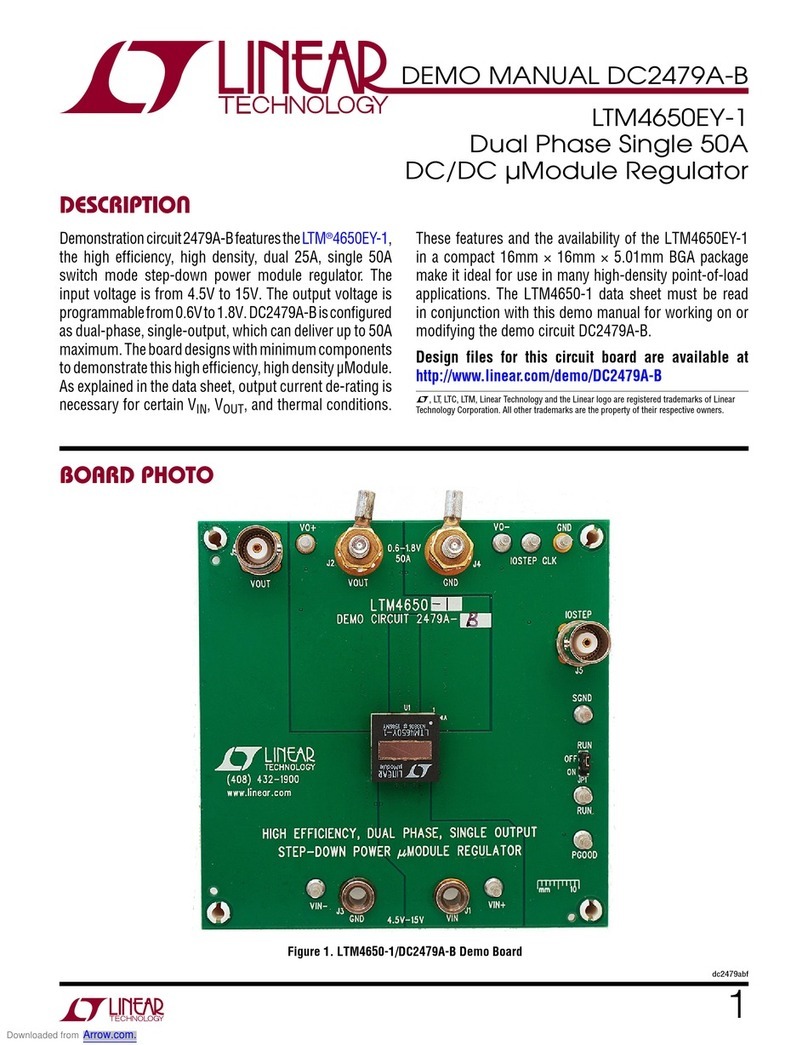
Linear Technology
Linear Technology LTM4650EY-1 Demo Manual

FS
FS FS-AC32 quick start guide

PIETRO FIORENTINI
PIETRO FIORENTINI REVAL 182 Use and maintenance instructions
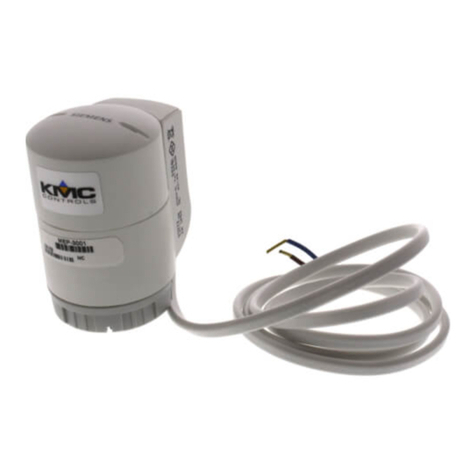
KMC Controls
KMC Controls MEP-3001 Installation and operation guide
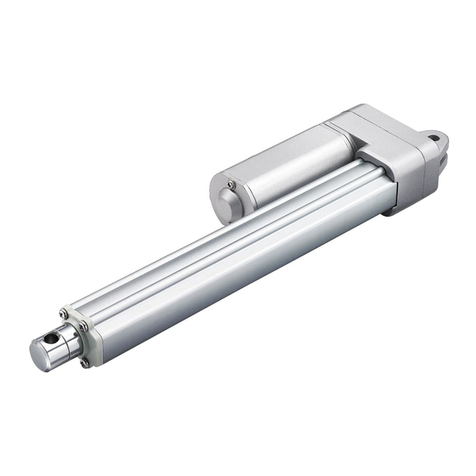
Timotion
Timotion TA16 user manual

